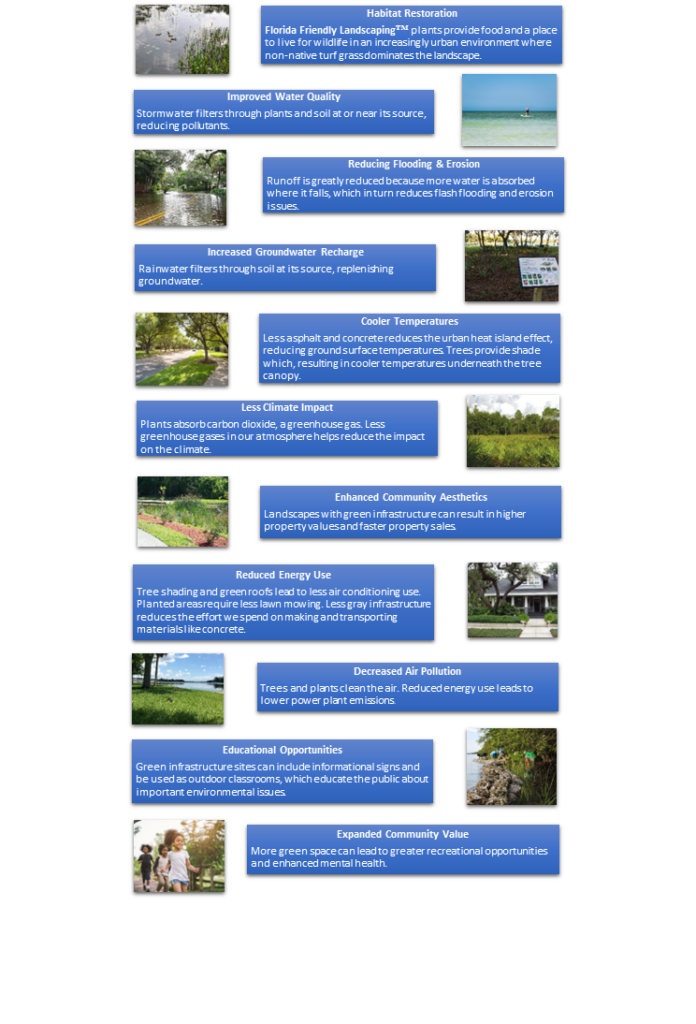The Resilient Pinellas Action Plan, released in June, has identified a number of initiatives for the County to undertake to make our community more sustainable and resilient, including increasing our use of green infrastructure practices. Pinellas County has been making strides toward green infrastructure programs and projects since the implementation of its Stormwater Manual in 2017.
By Josie Benwell
The renewed focus on stormwater – the leading cause of pollution in Tampa Bay – is particularly important to our community. A lack of space in the state’s most densely populated county limits the ability to treat stormwater conventionally, so innovative technologies are necessary as the County continues to redevelop.
So, what is green infrastructure?
Green infrastructure describes practices for managing stormwater or stabilizing shorelines that mimic nature in how they function, creating habitat and a host of other benefits in the process.
A good way to illustrate this concept is by reviewing two scenarios for managing stormwater runoff – one “gray” and one “green.” When rain falls in undeveloped areas (i.e., those that are completely natural), the water is filtered by plants and the soil. In developed areas, most of the rainwater cannot soak into the ground because of the increase in paved (impervious) surfaces, causing the stormwater to pool and to flow to the lowest point in the area. This stormwater “runoff” ultimately flows into the closest waterbody in the landscape, carrying fertilizer, petroleum products, animal waste and litter which degrade water quality. The graphic (figure 1) below depicts how the amount of impervious surface affects the amount of stormwater runoff produced.

Figure 1: A graphic depicting the change in the amount of stormwater runoff with various levels of paved (impervious) surface cover. The image was taken from the Pinellas County Green Infrastructure webpage.
There are two schools of thought on how to address this issue. In the traditional “gray” infrastructure approach, concrete structures, such as curbs, gutters, and pipes, are used to collect the stormwater runoff and transport it to a distant location – sometimes a large stormwater pond, but often directly to a creek, river, lake, Tampa Bay, or the Gulf of Mexico. The idea is to collect and move the water out of the area as quickly as possible to prevent flooding. This outdated methodology views stormwater as a nuisance rather than a resource, and does not address the source of the problem – excess runoff.
In the “green” infrastructure approach, efforts are made to minimize impervious surfaces, thus reducing the runoff initially generated, and then to slow the flow of water so it can infiltrate as close to its source as possible, mimicking nature. This is done by using practices like rain gardens, bioswales, planters, green gutters, pervious pavement, green roofs, and several other options spread throughout the area. These practices incorporate the use of native plants and soils to help filter pollutants from stormwater, along with providing other benefits like habitat for wildlife and cleaner air. The picture (Figure 2) below shows the difference between the two approaches.

Figure 2: Graphic from the University of Arkansas Community Design Center showing the difference between conventional stormwater management and stormwater management using green infrastructure (2010).
Why does it matter?
First and foremost, it matters because Pinellas County is restricted in the amount of available open space to construct traditional stormwater treatment ponds, coupled with the fact that we are surrounded by water on three sides, which is designated as Aquatic Preserve by the State of Florida for its environmental and regional significance. Many of the waterbodies in Pinellas County are considered “impaired” by the standards set by the Florida Department of Environmental Protection; therefore, it is important for the community to properly manage stormwater and other sources of pollution to improve and maintain water quality. The figure below illustrates just how little open area is available in the county. As shown in Figure 3 below, most of the land cover in Pinellas County is medium to high-density urban development.
Figure 3: Imagery from the National Land Cover Database (2016).
Lack of space to treat stormwater, and an increased need to remove pollutants from stormwater, lead us to realize that reducing runoff from roadways and development and providing decentralized treatment closer to its source is a better approach. In addition, high land costs in the county are a barrier for municipalities to buy land for building large stormwater treatment facilities. Below is an infographic (Figure 4) that helps to illustrate the constraints in Pinellas County, alongside some of our biggest priorities. All of this results in a need to change the way we think about managing stormwater runoff.
Figure 4: Fast facts about Pinellas County.
Green infrastructure provides a host of environmental benefits – “green” is in the name, after all. Green infrastructure provides increased pollutant removal, both from the water and air, improved habitat for wildlife, increased groundwater recharge, and reduces the impact our activities have on the climate.
Beyond the inherent environmental benefits, there are many other economic and social benefits to be realized by building green infrastructure. Less asphalt and concrete, and more trees and plants, provide a shading and cooling effect that lowers surface temperatures and reduces energy used for air conditioning.
Ever walked down a sidewalk or through a parking lot in Florida during the height of summer with no shade? It’s brutally hot, and nearly every Floridian I know will park in the furthest spot available if it’s under a tree that keeps temperatures cooler. And wouldn’t you love to spend less money every month on your electric bill? I know I would. I have a live oak tree in my front yard that is about three feet in diameter – it is incredible the difference in temperature on that side of the house compared to the other three sides with no mature trees.
Green infrastructure also enhances property values and community aesthetics. For example, view the following two scenarios in Figure 5 and imagine where you would rather spend time in or have in your neighborhood. I believe many people would prefer the options on the right.
Figure 5: Example photographs and renderings illustrating the difference in aesthetics between conventionally built sites and those that are incorporating green infrastructure.
Green infrastructure can also provide community benefits, such as reduced crime and improved mental health. Views of nature and natural walking paths can lower stress, improve alertness and improve employee satisfaction, attendance and performance at work. Reduced crime is another major benefit of preserving and incorporating nature into the built landscape. Figure 6 below provides additional detail on the many social and mental health benefits of green infrastructure.
Figure 6: A graphic summarizing many of the community benefits research has shown green infrastructure can provide, as detailed in “The Green Edge” National Resources Defense Council report and The Wildlife Trusts, UK.
Economic benefits include increased tourism from good water and air quality, reduced long-term construction and maintenance costs, enhanced property rental/sales and increased profit for businesses. For instance, desirable wetland views usually have a 5.7% to 7.5% rental premium. Additionally, these properties may be easier to rent, with higher occupancy rates and shorter periods between leases (The Green Edge, 2013). Conversely, large, unattractive retention ponds that lack recreation opportunities may decrease property values, as was found to be the case in a study done by Lee and Li in 2009. Numerous studies have found that consumers are willing to travel farther and shop more frequently in areas with attractive landscaping, good tree cover and green streets. In addition, customers have indicated a willingness to spend more — 8% to 12% more, in fact — on products at “green” shopping centers.

Figure 7: Graphic detailing some key findings from “The Green Edge” National Resources Defense Council report.
Figure 8: Graphic from a presentation on how Pinellas County is encouraging green infrastructure made at the Florida Stormwater Association summer conference in June 2021. This image details some of the many environmental, social, and financial benefits provided by incorporating green infrastructure into projects.
On the following page is a chart providing a summary of some of the many benefits of green infrastructure.

What can you do to help?
In short, the best thing you can do is to support the cause and to talk to others about it. The more people are educated about the issues we face and the things we can do to better address those problems, the more change we will see in the long run. Support your local government in completing these kinds of projects in your city or neighborhood. Be mindful about what you are doing in your daily life or on your own property that may be contributing, positively or negatively, to the environment we live in, and make changes to leave a net positive impact.
You may have heard of the term “net zero” being discussed in reference to the balance of greenhouse gases being released into versus what is removed from the atmosphere, but the term can also be applied to other concepts, such as waste, energy use and water pollution. A good rule of thumb is to try to generate as little impact (or footprint) as possible in your choices and day-to-day activities. Here are some of the things you can consider in your own life to help reduce your footprint:
- Use Florida-Friendly Landscaping™ practices.
- Conserve water.
- Reduce the amount of waste you produce, especially plastic, and recycle responsibly.
- Consider sustainability and toxicity when making purchases, including food.
- Reduce your energy use.
- Create a rain garden in a low spot on your property.
- Ensure that your roof downspouts are directed into your yard, not the driveway or street.
- If you need to replace concrete on your property, consider replacing it with a pervious option like pavers.
- Walk or bike when you can.
- When purchasing a new vehicle, consider more eco-friendly options.
- Support your local government in projects to increase sustainability and resiliency, including those that incorporate green infrastructure.
Josie Benwell is the manager of the Pinellas County Public Works Sustainability, Resilience, and Project Management Office. She earned degrees in environmental science and geography from the University of South Florida and has a master’s degree in environmental engineering Sciences from the University of Florida. Josie has 13 years of public sector environmental experience in Florida, including work with Pinellas County, the Florida Department of Environmental Protection, and the University of South Florida. Her current role involves managing a team of three staff involved in implementing sustainability and resiliency initiatives, conducting data analysis, and providing processes and resources for project managers. These efforts include planning for the incorporation of green infrastructure into capital projects and building resiliency into departmental practices.
